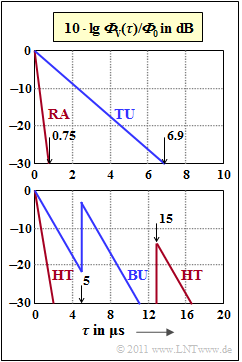Exercise 2.8: COST Delay Models
On the right, four delay power density spectra are plotted logarithmically as a function of the delay time τ
- 10⋅lg(ΦV(τ)/Φ0),
Here the abbreviation ϕ0=ϕV(τ=0) is used. These are the so-called COST–delay models.
The upper sketch contains the two profiles RA (Rural Area) and TU (Typical Urban). Both of these are exponential:
- ΦV(τ)/Φ0=e−τ/τ0.
The value of the parameter τ0 (time constant of the ACF) should be determined from the graphic in subtask (1). Note the specified values of τ−30 for ΦV(τ−30)=−30 dB:
- RA:τ−30=0.75µs,TU:τ−30=6.9µs.
The lower graph applies to less favourable conditions in
- urban areas (Bad Urban, BU):
- ΦV(τ)/Φ0={e−τ/τ00.5⋅e(5μs−τ)/τ0if0<τ<5µs,τ0=1µs,if5µs<τ<10µs,τ0=1µs,
- in rural areas (Hilly Terrain, HT):
- ΦV(τ)/Φ0={e−τ/τ00.04⋅e(15μs−τ)/τ0if0<τ<2µs,τ0=0.286µs,if15µs<τ<20µs,τ0=1µs.
For the models RA, TU and BU the following parameters are to be determined:
- The delay spread TV is the standard deviation of the delay τ.
If the delaypower density spectrum ΦV(τ) has an exponential course as with the profiles RA and TU, then TV=τ0, see Exercise 2.7.
- The coherence bandwidth BK is the value of Δf at which the magnitude of the frequency correlation function φF(Δf) has dropped to half its value for the first time. With exponential ΦV(τ) as with RA and TU the product TVis⋅BK≈0.276, see Exercise 2.7.
Notes:
- This task belongs to chapter GWSSUS–Kanalmodell.
- The following integrals are given:
- 1τ0⋅∫∞0e−τ/τ0dτ=1,1τ0⋅∫∞0τ⋅e−τ/τ0dτ=τ0,1τ0⋅∫∞0τ2⋅e−τ/τ0dτ=2τ20.
Questionnaire
Sample solution
- 10⋅lg(ΦV(τ−30)Φ0)=10⋅lg[exp[−τ−30τ0]]!=−30dB
- ⇒lg[exp[−τ−30τ0]]=−3⇒ln[exp[−τ−30τ0]]=−3⋅ln(10)⇒τ0=τ−303⋅ln(10)≈τ−306.9.
Here τ−30 denotes the delay that leads to the logarithmic ordinate value −30 dB. Thus one obtains
- for rural area (RA) with τ–30=0.75 µs:
- τ0=0.75μs6.9≈0.109µs_,
- for urban and suburban areas (Typical Urban, TU) with τ–30=6.9 µs:
- τ0=6.9μs6.9≈1µs_,
(2) In Exercise 2.7, it was shown that the delay spread is TV=τ0 when the delay power density spectrum decreases exponentially according to e−τ/τ0. Thus the following applies:
- for „Rural Area”: TV =0.109 µs_,
- for „Typical Urban”: TV =1 µs_.
(3) In Exercise 2.7 it was also shown that for the coherence bandwidth BK≈0.276/τ0 applies. It follows:
- BK ≈2500 kHz_ („Rural Area”),
- BK ≈276 kHz_ („Typical Urban”)
(4) The second solution is correct:
- Frequency selectivity of the mobile radio channel is present if the signal bandwidth BS is larger than the coherence bandwidth BK (or at least of the same order of magnitude).
- The smaller BK is, the more often this happens.
(5) According to the given equation, we have ΦV(τ=5.001 µs)/Φ0≈0.5_.
- On the other hand, for slightly smaller τ (for example τ=4,999 µs) we have approximately
- ΦV(τ=4.999μs)/Φ0=e−4.999µs/1μs≈e−5=0.00674_.
(6) The power P1 of all signal components with delays between 0 and 5 μs is:
- P1=Φ0⋅∫5μs0exp[−τ/τ0]dτ≈Φ0⋅∫∞0e−τ/τ0dτ=Φ0⋅τ0.
- The power outside [0μs,5μs] is
- P2=Φ02⋅∫∞5µsexp[5µs−ττ0]dτ≈Φ02⋅∫∞0exp[−τ/τ0]dτ=Φ0⋅τ02.
- Correspondingly, the percentage of power between 0 and 5 μs is
- P1P1+P2=23≈66.7%_.
The figure shows ΦV(τ) in linear scale:
- The areas P1 and P2 are labeled.
- The left graph is for BU, the right graph is for HT.
- For the latter, the power percentage of all later echoes (later than 15 µs) is only about 12%.
(7) The area of the entire power density spectrum gives P=1.5⋅ϕ0⋅τ0.
- Normalizing ΦV(τ) to this value yields the probability density function fV(τ), as shown in the next graph (left diagram).
- With τ0=1 µs and τ5=5 µs, the mean is:
- mV=∫∞0fV(τ)dτ
- ⇒mV=23τ0⋅∫τ50τ⋅e−τ/τ0dτ +
- + 13τ0⋅∫∞τ5τ⋅e(τ5−τ)/τ0dτ.
- The first integral is equal to 2τ0/3 according to the provided expression.
- With the substitution τ′=τ−τ5 you finally obtain using the integral solutions given above:
- mV = 2τ03+13τ0⋅∫∞0(τ5+τ′)⋅e−τ′/τ0dτ′=2τ03+τ53τ0⋅∫∞0⋅e−τ′/τ0dτ′+13τ0⋅∫∞0τ′⋅⋅e−τ′/τ0dτ′
- ⇒mV=2τ03+τ53+τ03=τ0+τ53≈2.667µs_.
- The variance σ2V is equal to the second moment (mean of the square) of the zero-mean random variable θ=τ–mV, whose PDF is shown in the right graph
- From this TV=σV can be specified.
- A second possibility is to first calculate the mean square value of the random variable τ and from this the variance σ2V using Steiner's theorem.
- With the substitutions and approximations already described above, one obtains
- mV2 ≈ 23τ0⋅∫∞0τ2⋅e−τ/τ0dτ+13τ0⋅∫∞0(τ5+τ′)2⋅e−τ′/τ0dτ′
- ⇒mV2=23⋅∫∞0τ2τ0⋅e−τ/τ0dτ+τ253⋅∫∞01τ0⋅e−τ′/τ0dτ′+2τ53⋅∫∞0τ′τ0⋅e−τ′/τ0dτ′+13⋅∫∞0τ′2τ0⋅e−τ′/τ0dτ′.
- With the integrals given above, we have
- mV2≈23⋅2τ20+τ253⋅1+2τ53⋅τ0+13⋅2τ20=2τ20+τ253+2⋅τ0⋅τ53
- ⇒σ2V = mV2−m2V=2τ20+τ253+2⋅τ0⋅τ53−(τ0+τ53)2=τ20+2τ259=(1µs)2+2⋅(5µs)29=6.55(µs)2
- ⇒TV=σV≈2.56µs_.
The above graph shows the parameters TV and σV.


